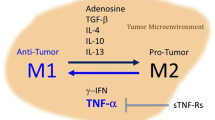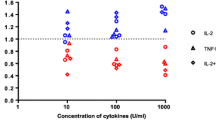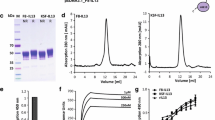Abstract
The mode of antitumor action of rHu-TNF was elucidated in BALB/c mice bearing Meth A fibrosarcoma 7 days after transplantation with respect to time course, dose-response relationships and selectivity of the effects. The maximal cytotoxic effect on tumor cells revealed by inhibition of DNA synthesis and maximal lesional effect on tumor vasculature revealed by change in blood pool-size in the tissue were detected at 30 min and I h after administration of rHu-TNF, respectively. The dose-response relationship between cytotoxic and tumoricidal effects of rHu-TNF was irrespective of administration route. ED50s of these antitumor effects afteri.v. administration of rHu-TNF were about 50 times as high as ED50s afteri.t. administration. ED50 ofi.t. given rHu-TNF for vascular effect was about 20 times as high as that for cytotoxicity while ED50 ofi.v. rHu-TNF for vascular effect was only 2–3 times as high as that for cytotoxicity. The whole body autoradiographies with [125I] HSA giveni.v. to see the blood influx into tumor tissue and [14C]thymidine given i.v. to see DNA synthesis in the whole body after administration of rHu-TNF revealed that the distribution of radioactivity was markedly changed in the tumor alone without any detectable change in other whole body tissues.
In conclusion, thein vivo antitumor effect of rHu-TNF giveni.t. ori.v., appears to be exerted through the direct action on Meth A sarcoma rather than indirectly on tumor vasculature. Under present conditions, the effect of rHu-TNF in the whole body tissues seems rather selective on cells and vasculature of the tumor.
Similar content being viewed by others
Abbreviations
- ED5 :
-
50% effective dose
- HE:
-
hematoxylin-eosin
- HSA:
-
human serum albumin
- i.t. :
-
intratumoral
- i.v. :
-
intravenous
- TNF:
-
tumor necrosis factor
- rHu-TNF:
-
recombinant human TNF
References
Old LJ. Tumor necrosis factor (TNF). Science (Wash. D.C.) 1985; 230: 630–32.
Carswell EA, Old LJ, Kassel RL, Green S, Fiore N, Williamson B. An endotoxin-induced serum factor that causes necrosis of tumor. Proc Natl Acad Sci USA 1975; 72: 3666–70.
Haranaka K, Satomi N, Sakurai A. Antitumor activity of murine tumor necrosis factor (TNF) against transplanted murine tumors and heterotransplanted human tumors in nude mice. Int J. Cancer 1984; 34: 263–67.
Kull Jr FC, Cuatrecasas P. Possible requirement of internalization in the mechanism ofin vitro cytotoxicity in tumor necrosis serum. Cancer Res. 1981; 41: 4885–90.
Rubin BY, Anderson SL, Sullivan SA, Williamson BD, Carswell EA, Old LJ. High affinity binding of125I-labeled human tumor necrosis factor (LuKII) to specific cell surface receptors. J Exp Med 1985; 162: 1099–1104.
Taguchi T. A phase I study of recombinant human tumor necrosis factor (rHu-TNF: PT-050) (in Japanese). Jpn J Cancer Chemnother 1986; 13: 3491–97.
Yamada M, Furutani Y, Notake M, Yamagishi J. Yamayoshi M, Fukui T, Nomura H, Komiya M, Kuwashima J, Nakano K, Sohmura Y, Nakamura S. Efficient production of human tumor necrosis factor in Escherichia coli. J Biothechnol 1985; 3: 141–53.
Yamazaki S, Onishi E, Enami K, Natori K, Kohase M, Sakamoto H, Tanouchi M, Hayashi H. Proposal of standardized method and reference for assaying recombinant human tumor necrosis factor. J Med Sci Biol 1986; 39: 105–18.
Sohmura Y, Nakata K, Yoshida H, Kashimoto S, Matsui Y, Furuichi H. Recombinant human tumor necrosis factor - II. Antitumor effect on murine and human tumors transplanted in mice. Int J Immunopharmac 1986; 8: 357–68.
Nawroth PP, Stern DM. Modulation of endothelial cell hemostatic properties by tumor necrosis factor. J Exp Med 1986; 163: 740–45.
Stolpen AH, Guinan AEC, Fiers W, Pober JS, Recombinant tumor necrosis factor and immune interferon act singly and in combination to reorganize human vascular endothelial cell monolayers. Am J Pathol 1986; 123: 16–24.
Ohboshi A. Pathology of cancer chemotherapy (in Japanese). Jpn J Cancer Chemother 1974; 1: 131–34.
Miyazaki H. Matsunaga Y, Hashimoto M. Distribution of [14C]labeled purines in the mouse: A whole body autoradiographic assessment of purine metabolism in mammals. J Histochem Cytochem 1978; 26: 663–76.
Haranaka K, Satomi N. Cytotoxic activity of tumor necrosis factor (TNF) on human cancer cellsin vitro. Japan J Exp Med 1981; 51: 191–94.
Nakano K, Abe S, Sohmura Y. Recombinant human tumor necrosis factor -II. Cytotoxic activityin vitro. Int J Immunopharmac 1986; 8: 347–55.
Manda T, Shinomura K, Mukumoto S, Kobayashi K, Mizota T, Hirai O, Matsumoto S, Oku T. Nishigaki F, Kikuchi H. Recombinant human tumor necrosis factor-α: Evidence of an indirect mode of antitumor activity. Cancer Res 1987; 47: 3707–11.
Bogoroch R. Liquid emulsion autoradiography. In: Gahan PB, ed. Autoradiography for biologists. London, New York: Academic Press Inc, 1972: 65–94.
Ullberg S. Studies on the distribution and fate of35S- labeled benzylpenicillin in the body. Acta Radiol (suppl) 1954; 118: 1–110.
Matsuoka O, Kashima M. Macroautoradiography and its application (in Japanese). Radioisotopes (Tokyo) 1966; 15: 195–207.
Author information
Authors and Affiliations
Rights and permissions
About this article
Cite this article
Miyazaki, H., Iida, M., Matsunaga, Y. et al. Mode of antitumor action of recombinant human tumor necrosis factor on the sarcoma Meth A transplanted in the mouse. Biotherapy 1, 47–57 (1989). https://doi.org/10.1007/BF02170135
Received:
Accepted:
Issue Date:
DOI: https://doi.org/10.1007/BF02170135




